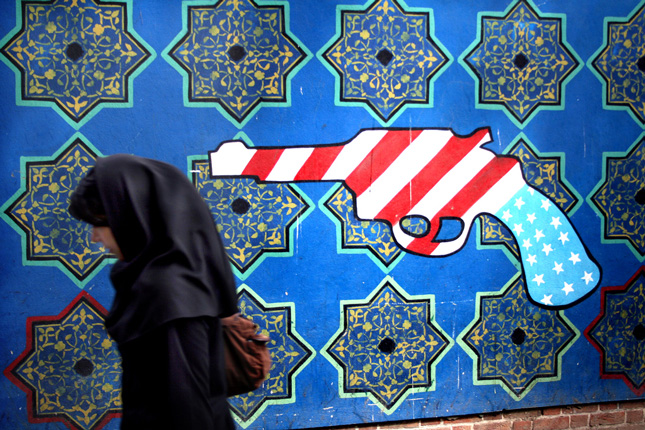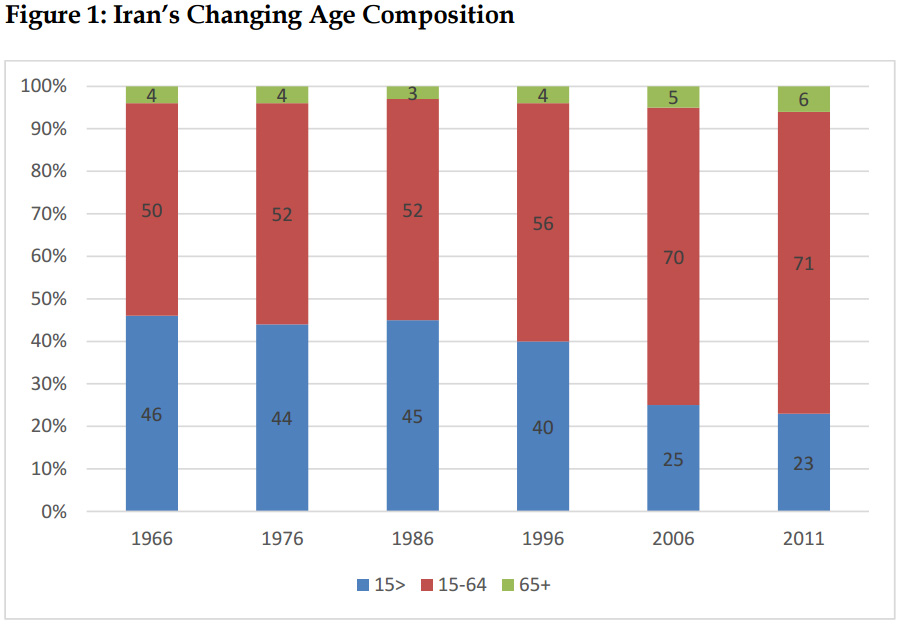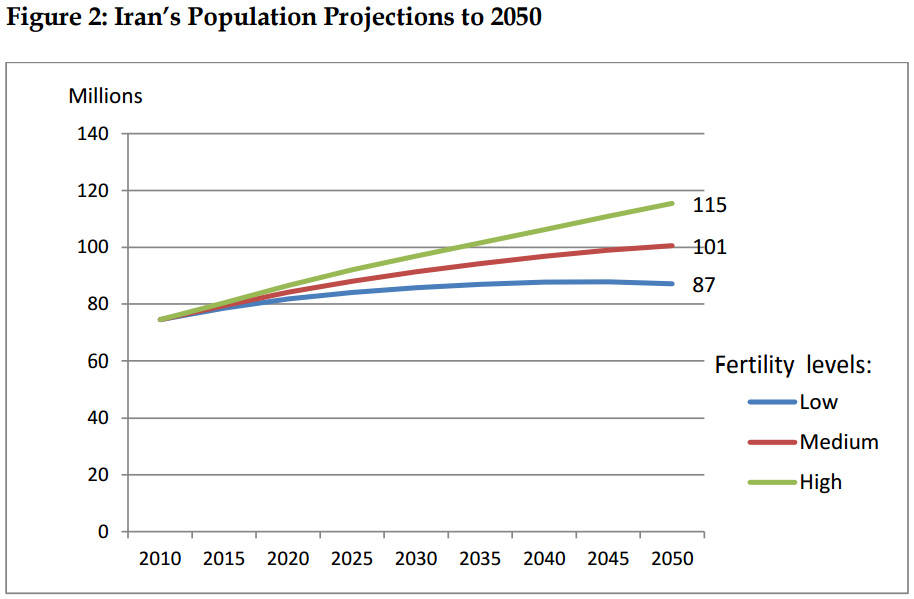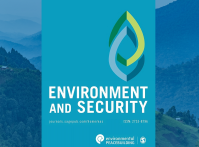-
A Nuclear Deal Could Help Iran Harness a Youthful Labor Force
July 7, 2015 By Farzaneh Roudi
Iran is poised to reap a vast “demographic dividend” if the appropriate national and international policies are adopted, including a nuclear deal with the P5+1 (five permanent members of the UN Security Council, plus Germany).
The demographic dividend is the accelerated economic growth that countries can experience when the working-age population expands relative to the total population, as is the case in Iran today. When more working-age adults have fewer children to support (because of declines in fertility), a country has a window of opportunity for rapid economic growth if the appropriate social and economic policies are in place. A nuclear deal that leads to the removal of economic sanctions on Iran could provide just this opportunity for Iran: a chance to participate in the global economy on a much greater scale and create much needed jobs for its large and relatively educated labor force.
2.5-3 million working-age adults are unemployedMore than 4 million students are enrolled in higher education and, over the next four years, will be poised to enter an extremely tight job market. Currently, an estimated 2.5 million to 3 million working-age adults are unemployed and looking for a job, even accounting for the large number of Iranians who continue to emigrate. Iran has experienced a significant brain drain since the Islamic Revolution in 1979. But, with the prospect of a nuclear deal and removal of sanctions, Iran could benefit from its large diaspora, who largely live in the West, by engaging them in the economy directly as investors or indirectly as a bridge between businesses outside and inside the country.
Seizing a Demographic Window of Opportunity
Iran is among the few countries in the Middle East and North Africa region, and in the Muslim world generally, that have completed the “demographic transition” – the shift from high mortality and fertility to low mortality and fertility. As economies develop and people’s education and health improve, death and birth rates start to decline. Death rates usually decline before birth rates do, resulting in a period of rapid population growth. In Iran, between the censuses of 1976 and 1986, the population grew rapidly, at an average of 3.9 percent per year (3.2 percent from natural increase and 0.7 percent from immigration).3 According to UN estimates, Iran reached its peak of 4 percent annual population growth in the early 1980s. The country’s population more than doubled in 30 years, from 34 million in 1976 to 71 million in 2006. It reached 78 million in 2015.
As countries complete their demographic transition, the size of the population eventually stabilizes if the total fertility rate (lifetime births per woman) settles at close to two births per woman – the rate at which couples replace themselves. The experiences of countries that have completed their demographic transitions, however, show that fertility often continues to fall below the replacement level. This has been the case in Japan and many European countries, as well as Iran. It has joined the group of countries whose fertility has been below the replacement level for more than a decade. Today, women in Iran have an average of 1.8 children. Life expectancy at birth increased from 52 years in the early 1970s to 74 years today, largely due to declines in infant and child mortality, which have pushed up average life expectancy. In the early 1970s, 1 in 8 infants in Iran died before reaching their first birthday, but by early 1990s, this ratio decreased to 1 in 24. By the early 2010s, it fell to 1 in 62, resulting in a much larger percentage of infants reaching adulthood and, in turn, having their own children. Today, Iran’s infant mortality rate is less than half of the world’s average.
With its declining fertility and rising life expectancy, Iran’s population has grown older: its median age rose from 17 in 1986 to 27 in 2011. In the 1970s and 1980s, nearly half of the population was under age 15, but that declined to only about a quarter of the population in 2011 (see Figure 1). Iran’s age structure has thus shifted: the working-age population (ages 15 to 64) grew from 52 percent of the total population in 1986 to 71 percent in 2011, presenting the country a “demographic window of opportunity” and positioning it to reap its demographic dividend. The dividend can occur when its age structure shifts toward more people in the working-age group relative to children and the elderly. With fewer dependents to support, a country has the potential for rapid economic growth if the right social and economic policies are in place to enable a young, educated population to enter the labor force and contribute to increased productivity and economic growth. The opportunity must be seized before the share of working-age population shrinks as it grows older. In Iran, the proportion of the elderly population ages 65 and over is expected to grow rapidly from 6 percent in 2011 to 20 percent by 2050, as the baby boomers of 1970s and 1980s reach age 65.
Iran’s baby boomers are now in their reproductive years. Even though they are having fewer children than their parents did, the sheer number of couples having children gives momentum to the country’s population growth. According to projections by the United Nations Population Division, Iran’s population will grow to 87 million by 2050 even if the fertility rate falls to 1.3 or 1.4 births per woman between now and 2050. The population would increase to more than 100 million if fertility stayed at 1.8 or 1.9 births per woman, and to more than 115 million if fertility rose to 2.3 or 2.4 births per woman (see Figure 2).
Jobs First, Babies Later
Some Iranian officials, including the Supreme Leader Ayatollah Ali Khamenei, have advocated for larger families in an effort to prevent population decline, which could happen in the long term if fertility remains below the replacement level.
The government’s pronatalist posturing began under President Mahmood Ahmadinejad (2005 to 2013), when a range of policies and programs encouraging young people to marry and have more children were introduced. One of his controversial promises called for the Central Bank to deposit one million Tooman (about $350 at June 2015 exchange rate) into a bank account for each newborn and 100,000 Tooman ($35) each year until the child reaches 18, but the program ended after six months due to lack of budget. Earlier this year, the Parliament passed a law that reduces the country’s compulsory military service for married men with children. The fate of another controversial bill that calls for limiting couple’s access to modern contraceptives is not yet certain; health and human rights advocates, both inside and outside of the country, have warned against its negative consequences.
Countries generally have but one chance for the demographic dividendWhile there is no internationally published study assessing family size preferences among men in Iran, data on contraceptive use reported by women indicate that men are involved in family planning decisions and practices. Three-quarters of married women ages 15 to 49 practice family planning, with half of them relying on methods that require their husbands’ participation (withdrawal, rhythm, condom, or vasectomy). Anecdotal evidence suggests that men want to avoid large families as much as women do – if not more – because men generally bear the economic burden of supporting the family. Indeed, the country’s economic situation and high cost of living, especially housing, have not been conducive to young people marrying and having large families, despite government incentives.
The results of a labor force survey conducted in the fall of 2014 by the Statistical Center of Iran show an unemployment rate of 22 percent among youth ages 15 to 29, not accounting for those who had given up seeking work and left the job market or those who left the country. The survey also reveals that one-third of unemployed youth are female. It is not surprising that young men and women are not rushing to marry and have children as some government officials expect them to do, when they lack economic security, which is essential in forming a family.
The prospect of a nuclear deal and removal of economic sanctions could help Iran transform its economy to accommodate its large and educated labor force – about one quarter of Iran’s working-age population has a university degree – and reap a demographic dividend. The unemployment rate is higher among university graduates than among less-educated job seekers. Unemployment is high even among university graduates with technical degrees, such as computer sciences (30 percent), biological sciences (26 percent), and engineering (22 percent).
It is time for Iran to capitalize on its human capital by allowing its labor force to compete in the global market. Countries generally have only one chance to reap the demographic dividend as they go through the demographic transition. Iran cannot afford to miss it.
Farzaneh Roudi is the program director for the Middle East and North Africa at the Population Reference Bureau.
Sources: Brandies University, Iranian Ministry of Health and Medical Education, Population Reference Bureau, Statistical Center of Iran, UN Population Division.
Photo Credit: Graffiti outside the former U.S. embassy in Tehran, courtesy of flickr user Örlygur Hnefill.
 A Publication of the Stimson Center.
A Publication of the Stimson Center.








